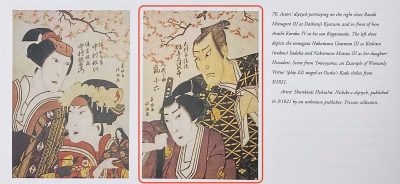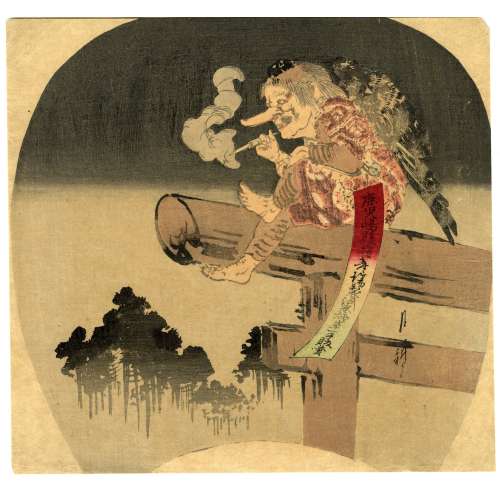Bandō Mitsugorō III as Daihanji Kiyozumi and Arashi Koroku IV as Koganosuke in kabuki play
Imoseyama, an example of womanly virtue (Imoseyama onna teikin).
大判事清澄 坂東三津五郎」(三代)・「久我之助 嵐小六」(四代)
Artist:
Shunkōsai Hokushū [春好斎北洲] (Japanese, fl. 1802 – 1832)
Year: 1821 (3
rd month).
MFA description: “The Kabuki play Mount Imo and Mount Se: An Exemplary Tale of Womanly Virtue (Imoseyama onna teikin), originally based on a puppet play, is set in ancient Japan when the Soga clan served as regents to the emperor. Two children, Hinadori and Koganosuke, of rival court families, are held hostage under orders from the tyrant Soga no Iruka to ensure their families do not revolt. The children fall in love, but rather than create conflicts for their families they each vow to die by suicide. When the parents learn of their plans, they resolve to cooperate to overthrow Iruka. Here Koganosuke and his father Kiyozumi are shown; a companion sheet on the left would have shown Hinadori and her mother Sadaka.”
The play Imoseyama, an example of womanly virtue (Imoseyama onna teikin), was staged at Osaka's
Kado Shibai (Kadoza, Kado Gekijô, Kado no Shibai) from 3/1821.
According to Herwig, it is the right sheet of a diptych (see below).
MFA Accession number:
2011.128
Kabuki actors:
Bandō Mitsugorō III [三代目 坂東 三津五郎] (Japanese, 1775 – 1831); other names: Bandō Minosuke I, Morita Kanjirô II, Bandō Mitahachi I, Bandō Minosuke I, Bandō Mitahachi I.
Arashi Koroku IV [四代目嵐小六] (Japanese, 1783 – 1826)
Ref.: [
LIB-1197.2016] Arendie and Henk Herwig. Heroes of the kabuki stage: an introduction to kabuki with retellings of famous plays, illustrated by woodblock prints. — Amsterdam: Hotei Publishing, 2004; p. 72:

Ref: [
LIB-2973.2022] Ukiyo-e: A journey through the Floating World / Exhibition catalogue (Japan, Jan-Jul 2014). — The Yomiuri Shimbun, 2014; № 358, p. 226. "Bandō Mitsugorō III as Grand arbiter Kiyosumi and Arashi Koroku IV as Koganosuke":
























